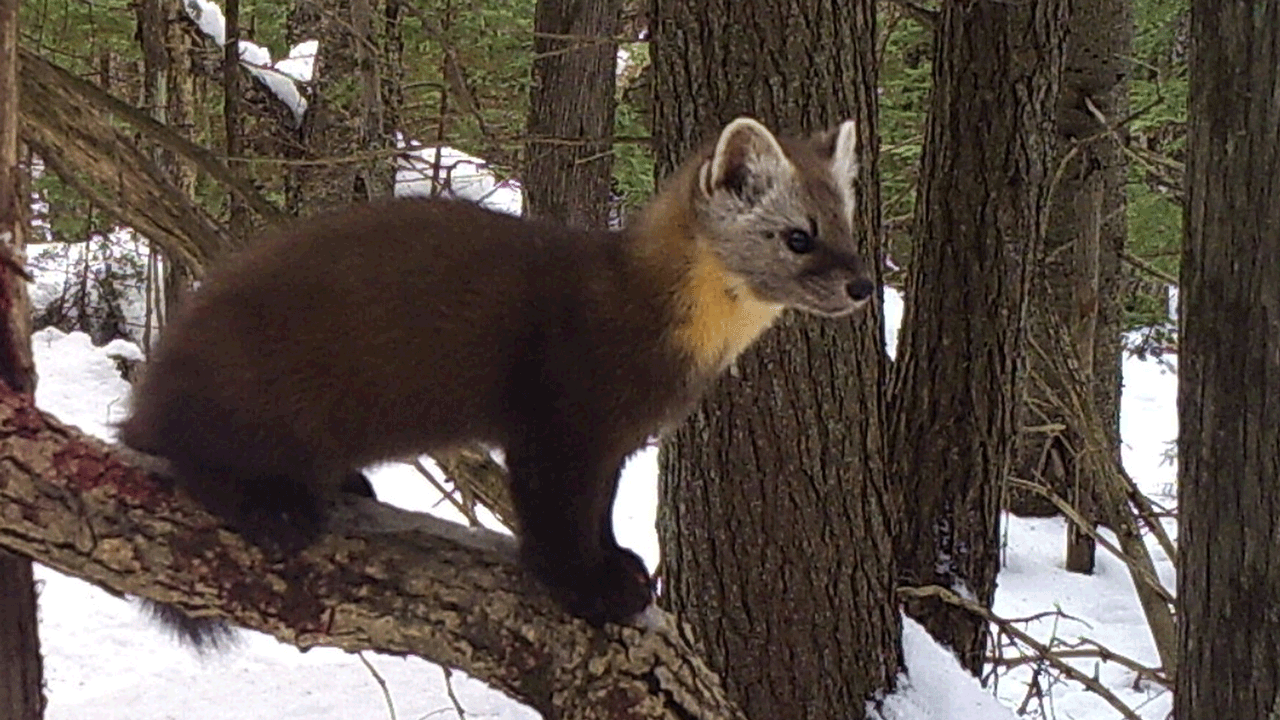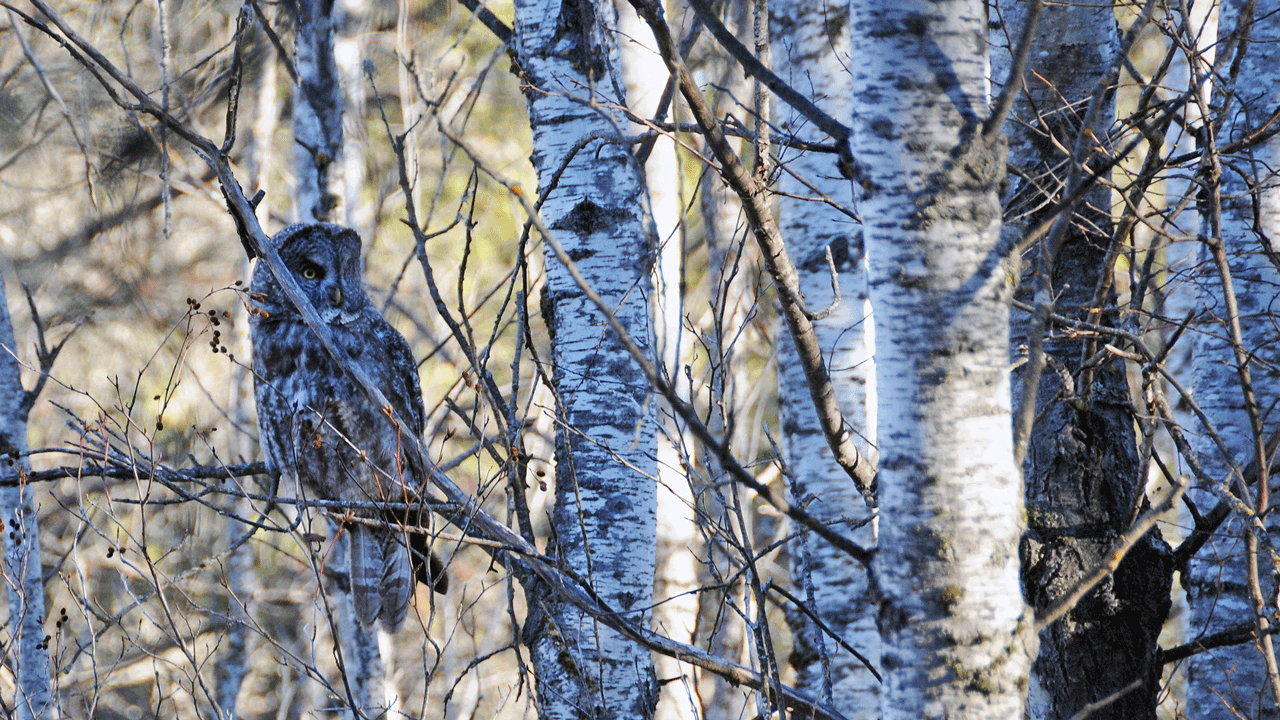As one of three predators working the same mountainside on a recent September morning, I declared myself the least skilled and most likely to starve if relying solely on my ears and nose to find prey.
Not that we were competing, of course. I was bowhunting elk, while my fellow predators – two American martens and one great gray owl – were targeting voles and mice.
I doubted the martens were hunting as a team. From what I’ve read and heard, martens are solitary animals, seldom pairing except during their July-through-August breeding season. Maybe this couple was simply late to propagate.

The American marten sitting atop a log.
Whatever their situation, they side-hilled their way toward me with a faint rustling of leaves. Before spotting and identifying them, I assumed they were just another couple of chipmunks or pine squirrels approaching, two of the forest’s most diligent foragers.
But then I heard low, guttural sounds suggesting a mix of curiosity and irritation. I’d heard similar growling/purring the previous evening a mile south in the valley behind our campsite. Soon after I identified an American marten hopping and trotting along the fallen trunk of a lodgepole pine.
On this morning, however, it was two martens, and they separated to zigzag around me; one bouncing uphill and one hopping downhill. The downhill marten crossed the ditch below, scrambled up a dead pine, and watched me with curiosity. Seconds later the other marten entered the ditch, drank from the elk wallow I was watching, and hopped toward its treed partner. Soon after they disappeared up the opposite hillside.
If you’ve ever seen martens bouncing through a forest, you wonder how they ever succeed as hunters. They look as attentive as grade-schoolers trying to play hopscotch atop a balance beam. But don’t let their perpetual motion deceive you. According to marten researcher, Zach Wilson, a researcher and conservation specialist with the Land and Water Conservation Department in Hurley, Wisconsin, martens engage their ears, eyes and nose to detect prey as they corkscrew along.
“They have a heck of a metabolism, so they have to eat often,” Wilson said of these long, slender members of the weasel family. Measuring 18 to 25 inches and weighing 1 to 3 pounds, adult martens are bigger than mink but smaller than fishers, and distinguished by rusty to burnt-orange throats and chest bibs.
Wilson said martens run atop logs whenever they get a chance, unlike fishers, which tend to bounce along atop the snow or ground. “Given a choice, martens run that log rather than run around it,” he said. “Maybe they like that extra height advantage up on top.”
And whatever you do, don’t call them “pine martens” when talking to Wilson or other wildlife biologists, who have spent the past 30 years trying to rid North Americans of a long-running misnomer. Real pine martens are found only in Europe. American martens range from Alaska to northern Maine; and dip into the upper Great Lakes states, and the Rockies and northern California.
Martens are rare in most of the Midwest and East, but plentiful in Michigan’s Upper Peninsula and northeastern Minnesota’s “Arrowhead” region. They favor areas with good populations of mice and voles.

A great gray owl watches and listens for voles and mice in an aspen stand.
Likewise, great gray owls favor those prey, but range eastward only to western Quebec. These big owls stand taller and boast longer wingspans than great horned and snowy owls, but weigh roughly half as much.
I’ve identified one great gray owl while deer hunting in Minnesota’s Boundary Waters region, and three others while bowhunting elk in Idaho. About an hour after the American martens checked me out that September morning, a great gray owl glided past about 20 yards away and alighted silently atop a branch in the pine where the martens reunited after skirting me.
Three years earlier when bowhunting elk in the same area, I got between an adult great gray and its nearly full-sized offspring, which called incessantly for food. At least that’s what Professor Stanley Temple at the University of Wisconsin-Madison surmised when hearing my account.
Minutes after this year’s great gray settled in, the big owl swiveled its head and stared at me until I felt spooked. Great grays have piercing yellow eyes and a round face that looks almost human the longer they stare at you. Just about when I expected it to interrogate me in English, it pitched from its perch and glided 30 yards to another dead tree. It then studied the laurel brush downhill, and hopped a few feet to yet another perch.
The owl seemed intense, focusing its pie-shaped face on one spot. A minute later, it leaned forward and swooped into the brush. I couldn’t see what it struck. Neither did I see it relaunch into the air. But knowing great grays can nail voles and mice 2 feet deep in snow, I’m betting its talons secured a meal.
Temple said great gray owls have incredibly sensitive hearing, and can audibly track mice scurrying through snowy tunnels. That’s because great gray’s left ear opening is higher on their head than their right ear to help triangulate sounds.
“They also have that incredible feathery disk of a face, which acts like a parabolic reflector to amplify sound and direct it to their ears,” Temple said. “They’re a finely tuned listening machine. They have no problem hunting in darkness, relying totally on their hearing.”
And, much like the American marten, great gray owls are rare in most areas. Most sightings in the Great Lakes states occur during winter “irruptions,” when some great grays drop southward from Canada seeking more abundant food sources.
It’s too soon to know if many great grays will visit this winter, but we might get some early indications around Thanksgiving as cold weather arrives.
Some of us will be hunting deer about then, presumably with less consistency and competence than other predators like martens and owls hunting small rodents.

 By
By 



